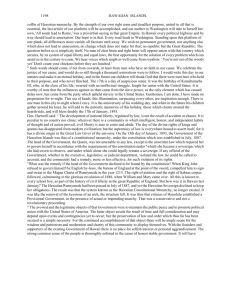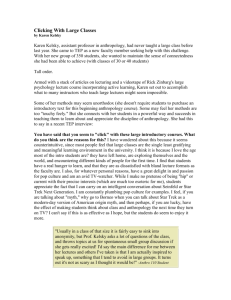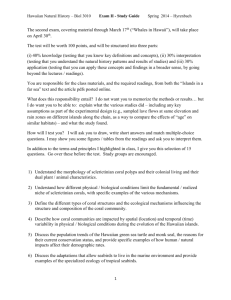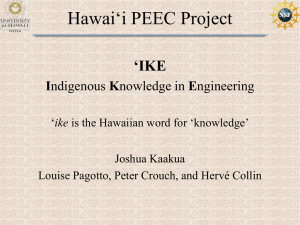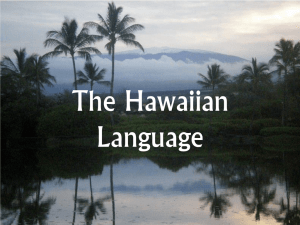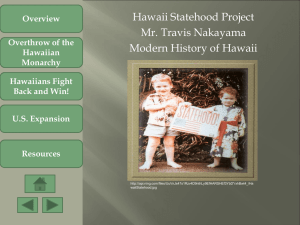AAPI Culture Brief: Hawai`i - National Technical Assistance Center
advertisement
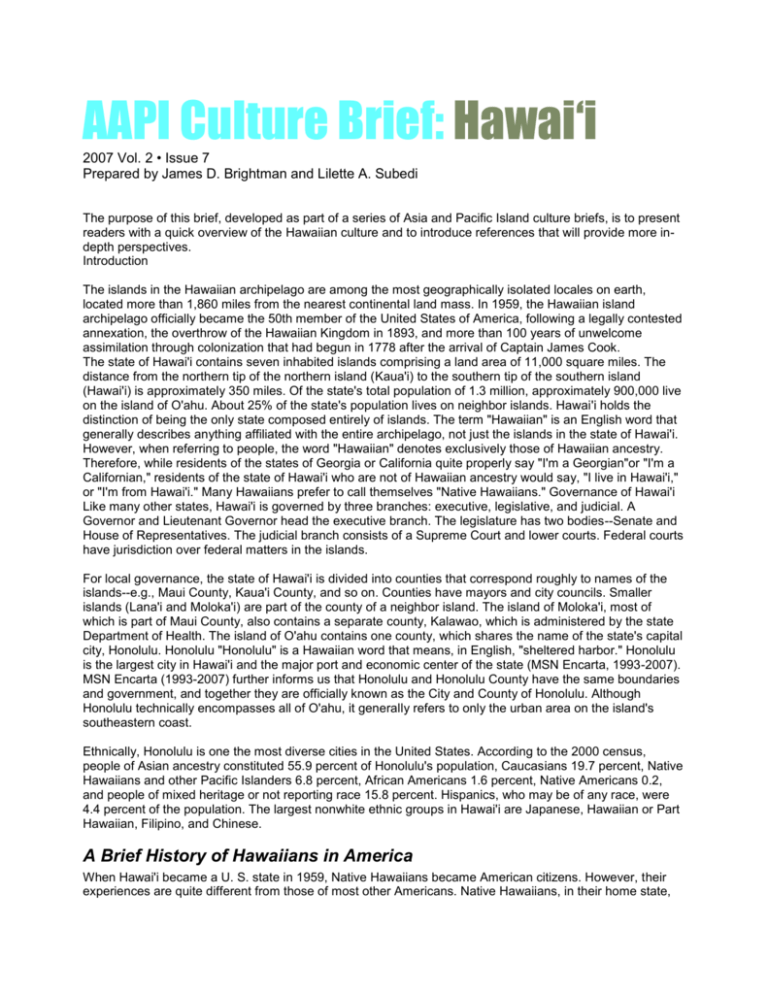
AAPI Culture Brief: Hawai‘i 2007 Vol. 2 • Issue 7 Prepared by James D. Brightman and Lilette A. Subedi The purpose of this brief, developed as part of a series of Asia and Pacific Island culture briefs, is to present readers with a quick overview of the Hawaiian culture and to introduce references that will provide more indepth perspectives. Introduction The islands in the Hawaiian archipelago are among the most geographically isolated locales on earth, located more than 1,860 miles from the nearest continental land mass. In 1959, the Hawaiian island archipelago officially became the 50th member of the United States of America, following a legally contested annexation, the overthrow of the Hawaiian Kingdom in 1893, and more than 100 years of unwelcome assimilation through colonization that had begun in 1778 after the arrival of Captain James Cook. The state of Hawai'i contains seven inhabited islands comprising a land area of 11,000 square miles. The distance from the northern tip of the northern island (Kaua'i) to the southern tip of the southern island (Hawai'i) is approximately 350 miles. Of the state's total population of 1.3 million, approximately 900,000 live on the island of O'ahu. About 25% of the state's population lives on neighbor islands. Hawai'i holds the distinction of being the only state composed entirely of islands. The term "Hawaiian" is an English word that generally describes anything affiliated with the entire archipelago, not just the islands in the state of Hawai'i. However, when referring to people, the word "Hawaiian" denotes exclusively those of Hawaiian ancestry. Therefore, while residents of the states of Georgia or California quite properly say "I'm a Georgian"or "I'm a Californian," residents of the state of Hawai'i who are not of Hawaiian ancestry would say, "I live in Hawai'i," or "I'm from Hawai'i." Many Hawaiians prefer to call themselves "Native Hawaiians." Governance of Hawai'i Like many other states, Hawai'i is governed by three branches: executive, legislative, and judicial. A Governor and Lieutenant Governor head the executive branch. The legislature has two bodies--Senate and House of Representatives. The judicial branch consists of a Supreme Court and lower courts. Federal courts have jurisdiction over federal matters in the islands. For local governance, the state of Hawai'i is divided into counties that correspond roughly to names of the islands--e.g., Maui County, Kaua'i County, and so on. Counties have mayors and city councils. Smaller islands (Lana'i and Moloka'i) are part of the county of a neighbor island. The island of Moloka'i, most of which is part of Maui County, also contains a separate county, Kalawao, which is administered by the state Department of Health. The island of O'ahu contains one county, which shares the name of the state's capital city, Honolulu. Honolulu "Honolulu" is a Hawaiian word that means, in English, "sheltered harbor." Honolulu is the largest city in Hawai'i and the major port and economic center of the state (MSN Encarta, 1993-2007). MSN Encarta (1993-2007) further informs us that Honolulu and Honolulu County have the same boundaries and government, and together they are officially known as the City and County of Honolulu. Although Honolulu technically encompasses all of O'ahu, it generally refers to only the urban area on the island's southeastern coast. Ethnically, Honolulu is one the most diverse cities in the United States. According to the 2000 census, people of Asian ancestry constituted 55.9 percent of Honolulu's population, Caucasians 19.7 percent, Native Hawaiians and other Pacific Islanders 6.8 percent, African Americans 1.6 percent, Native Americans 0.2, and people of mixed heritage or not reporting race 15.8 percent. Hispanics, who may be of any race, were 4.4 percent of the population. The largest nonwhite ethnic groups in Hawai'i are Japanese, Hawaiian or Part Hawaiian, Filipino, and Chinese. A Brief History of Hawaiians in America When Hawai'i became a U. S. state in 1959, Native Hawaiians became American citizens. However, their experiences are quite different from those of most other Americans. Native Hawaiians, in their home state, are an involuntary minority. Involuntary minorities--individuals brought to the United States through slavery, conquest, or colonization--interpret the same obstacles differently and without a frame of reference (Pe–a, 1997). The experiences of Native Hawaiians in the islands, thus, are more closely aligned with those of Native Americans--another colonized population--than with any voluntary minority groups. This may explain why Native Hawaiians and Native Americans prefer those titles, because they stress individuals' heritage and, possibly, the involuntary nature of their minority status (Subedi, 4 July 2007). Some Hawaiian people refuse to call themselves Americans. Asians and Caucasians, who came to Hawai'i for a variety of reasons, currently, far outnumber Native Hawaiians and other Pacific Islanders in the archipelago. The number of Native Hawaiians declined drastically after Captain James Cook arrived in Hawai'i in 1778, when their population was, according to estimates, between 300,000 and 400,000. Disease and other factors in the next 100 years caused the Native Hawaiian population to decline to an estimated 40,000 or 50,000 people. This number has increased to about 260,000 Native Hawaiians living in Hawai'i today. In addition, more than 100,000 Native Hawaiians live in the continental United States, especially Washington, Oregon, and California (Wikipedia, 2007). A Snapshot of Hawaiian Culture Whether in the state of Hawai'i or in the contiguous United Sates, Native Hawaiians have a history and a culture that are vastly different from that of most other Americans. Since rehabilitation providers will very likely encounter Native Hawaiians with disabilities at some point in their career, being aware of their cultural background will greatly facilitate communication. As reported by Sheehey, culture is the shared values, traditions, arts, history, folklore, and institutions of a group of people that are unified by race, ethnicity, nationality, language, religious beliefs, spirituality, socioeconomic status, social class, sexual preference, politics, gender, age, disability, or any other cohesive group feature. Alternatively, culture can be described as a learned pattern of customs, beliefs, norms, values, and behavior that are socially transferred through shared meanings, and passed on from generation to generation or group to group (Sheehey, 2001). The culture and the history of the Hawaiian Islands is extensive and would take years of study to fully comprehend; however, one of the defining qualities of the Hawaiian Islands is the Aloha Spirit. Hawai'i is frequently referred to as the "Land of Aloha," and the Aloha Spirit can be felt by most visitors to the islands. Aloha is said to be the coordination of mind and heart within each person; it brings each person to the self; each person must think and emote good feelings to others (Ala Mua Hawai'i, 2002). Other definitions indicate that "aloha" means love, affection, compassion, mercy, sympathy, pity, kindness, sentiment, grace, charity; greeting, salutation, regards; sweetheart, lover, loved one; beloved, loving, kind, compassionate, charitable, lovable; to love, be fond of; to show kindness, mercy, pity, charity, affection; to venerate; to remember with affection; to greet, hail or 'Greetings!' 'Hello!' 'Good-by!' 'Farewell!' 'Alas!' (Flores, 2003-2004). Consequently, most kama'aina (a Hawaiian word commonly used to refer to long-time residents of Hawai'i, as distinguished from visitors) are proud of being from the land of aloha. The Aloha Spirit is a large component of Native Hawaiian culture. When dealing with rehabilitation of Native Hawaiian consumers on the continental U. S., counselors should always remember the Aloha Spirit and its influence on everything Hawaiians do. While it is not always the optimal character trait for each and every interaction, aloha is a ubiquitous character trait for most Hawaiians. Another important cultural value is the Hawaiian view of disability. Sheehey (2001) summarized Hawaiian cultural values related to disability and some possible disadvantages in her dissertation about Hawaiian families' involvement in special education. Hawaiian culture is based on the assumptions of a collectivist society where the group's goals hold more importance than those of the individual. Relationships are the core to Hawaiian values. In particular, the relationship of the individual to the family, the community, the land, and the spiritual world is emphasized. The 'ohana (family) is the fundamental unit in Hawaiian culture. Family is defined as relatives by blood, marriage, and adoption. The needs of the family override the needs of individual family members (p. 52). In her research, Sheehey (2001) determined that, since Hawaiians value relationships, they may not want their children encouraged to make personal choices and decisions. Making personal choices and decisions may, in some circumstances, be perceived as not embracing your heritage or appreciating your family. However, a Native Hawaiian researcher and scholar who has experience teaching in Hawai'i, disagrees with Sheehey and claims there are "deeper issues" and more factors to consider when looking into parental involvement (Subedi, 4 July 2007). Providers may need to abandon their long-held cultural assumptions. For instance, when considering academics, it is easy to say that Hawaiians are under-achieving, but that might not be a completely accurate assessment. Looking at the situation slightly differently, at the risk of oversimplifying a complex issue, learning that is socially transferred is highly valued by Hawaiians but not as highly valued as academic learning in schools in the rest of the U.S. Therefore, Native Hawaiians, as well as many other minority students, may be perceived as incapable and, consequently, have high dropout rates and academic underachievement (Pe–a, 1997). Family and Community Structure On July 4th, 1776, when the United States of America was founded, there were only 13 states. Because much of the Declaration of Independence explicitly mentions the rights of individuals, it can be said that the U. S. was founded on individualism. Each person in America was expected to be responsible for his or her own success as well as his or her own failures. Much of that thinking is still prevalent in the United States. But Hawai'i was not part of the original United States and did not become so until almost 200 years later. Native Hawaiian society is collectivist. Collectivists focus on community and society, and seek to give priority to group goals over individual goals. The philosophical underpinnings of collectivism are related to holism; concisely summarized by Aristotle: "The whole is more than the sum of its parts." However, collectivism stifles individuality and diversity by insisting upon a common social identity. Moreover, following the colonization spawned by the arrival of Captain Cook, and the subsequent overthrow of the Hawaiian monarchy, the "disconnect" between American individualism and native Hawaiian collectivism results in many Native Hawaiians feeling somewhat "conflicted" (Subedi, 2 August 2007). They feel trapped in what can be referred to as, a "post-colonial trauma." Subedi (4 July 2007) explains, [Those individuals] "feel confused, angry, hurt and lost in today's complex world. They want what everybody wants and has--the latest i-phone and other techno-gadgetry, mega-screen high-def digital TVs, gas guzzling SUVs, fast food takeout and other trappings." [However, wanting such things seems to mean they are somehow denying their native Hawaiian heritage, which was clearly different before the arrival of Captain Cook]. View of Disability As previously indicated, collectivist cultures strive for a common social identity, which can make life difficult for individuals with disabilities. Individuals with disabilities may feel especially stifled, since the experience of and reaction to disability is an individual experience. Moreover, individuals with disabilities are viewed in one of two ways in Hawai'i: Subedi (14 July 2007) explains that in contemporary Hawaiian culture, e'epa is the word commonly used as slang to refer to someone who is short of something, whether it is intellectual acuity, emotional sensibility, or even a physical disability. The original meaning of that word is mysterious and somewhat mystical, linked to spiritual nature that is enigmatic to most. Another word, i hepa, literally refers to someone who behaves foolishly; one who does not think or pay regard/respect to what and who is around him/her. In Hawai'i, whether a person with disability is perceived as e'epa or i hepa can substantially influence the amount of support or the acceptance that a person receives from family and friends; and how much that person matches the common social identity. Providing Rehabilitation Services to Hawaiians In serving Hawaiians with disabilities, providers need to pay attention to the relevant history influencing those they are serving. Providers must remember that everything is contextual and they need to leave their preconceptions at the door. Providers must carefully consider the cultural, family, and community structures described in this brief. How counselors communicate with each individual and the individual's family, and whether recommendation or advice is in order, is completely dependent on how communications and recommendations are perceived and what they mean to the individual and the family. Recommendations to Rehabilitation Service Providers One of the most important things providers can do to help Hawaiians is to help prevent disabling conditions that may develop from unhealthy behaviors and to help Hawaiians try to become healthier individuals. Native Hawaiians tend to be the most overweight among all ethnic populations in Hawai'i--nearly 50 percent of Native Hawaiians are obese (Aiu, 2000). The lack of proper nutrition contributes to their obesity as well as to other chronic diseases such as diabetes and cancer, both of which are high among Native Hawaiians. The percentage of Native Hawaiians who smoke cigarettes is higher than the national average (Aiu, 2000). Considering the inexperience that most rehabilitation counselors have with foreign cultures and thinking, they need to be especially resourceful and persistent (Hong, 1995). Even though Hawai'i is part of the United States, Native Hawaiian culture remains foreign to most rehabilitation providers in the contiguous U.S. Thus, when connecting with individuals to meet their needs, services should, at the very least, be culture-specific, if not individual-specific. Essentially, providers should remember how they have been trained and remain very open and accepting as they try to develop therapeutic relationships. Ways You Can Become More Familiar with Hawaiian Culture Providers must understand Hawaiian cultural norms before attempting to be of service. Understanding Hawaiian cultural norms is a daunting task. Native Hawaiians and other Pacific Islanders, similar to Asian Americans, remain underserved by Vocational Rehabilitation, but one way to help them become better served is understand that contemporary Hawaiians are mostly multi-ethnic, multi-racial individuals with a variety of cultural influences. The National Technical Assistance Center for Asian Americans and Pacific Islanders with disabilities exists to rectify the disparity in rehab service utilization. Extensive information about the disparity can be found on the NTAC-AAPI website (www.ntac.hawaii.edu). To better understand Hawaiian culture and its influence on the Hawaiian people, providers should consider spending long amounts of time in the islands, reviewing the websites contained in the reference list of this brief, and looking at the following Hawaiian history website: http://www.hawaiianlinks.com/history.html Author Notes James D. Brightman is the Vocational Rehabilitation Coordinator for the National Technical Assistance Center for Asian Americans and Pacific Islanders [NTAC-AAPI] with Disabilities within the Center on Disability Studies. Lilette A. Subedi is Native Hawaiian and a Curriculum Specialist for the Curriculum Research and Development Group. Both authors are located at the University of Hawai'i at Mnoa. Postscript: Pronunciation You show respect for Hawaiian culture when you write and speak Hawaiian words correctly. Wight (2005) provides the following guide for pronunciation: Hawaiian consonants are said the same as they are in English, except for w, which is usually pronounced like v after i and e. Vowel sounds: like a in was: (olon) e like e in red: (he'e) like a in baby: (nn) like e in me: (imu, k) like o in go: (kalo, k) like oo in moon: (hula, pa') Generally, you say most vowels in a Hawaiian word, as when you say "Honolulu." Sometimes two vowels go together: ai, ao, au, ei, eu, oi, ou. The vowel sounds are rolled together as you say them, with the first one being stronger. You may have already noticed the pronunciation mark that looks like an upside down (or backwards) apostrophe, as in "Hawai'i." This mark is called an "okina" and indicates a slight break in the voice when saying a wordÑsort of like when you say "oh oh." (The okina is not an apostrophe.) Another pronunciation mark is called a "micron," which appears as a line over a letter, as in the word "Manoa." The micron signals that the letter, or the syllable in which the letter appears, should receive a vocal emphasis when saying the word. Thus "Manoa" should be pronounced "MA-noa." The famous extinct volcano on the island of Maui is named "Haleakal" and pronounced "Hale-akaLAH." References Aiu, P. (2000). Comparing Native Hawaiians' health to the nation. Office of Minority Health Resource Center/U.S. Department of Health and Human Services. Accessed 8 August 2007 via: http://www.omhrc.gov/ Ala Mua Hawaii (2002). Hawaiian culture. Accessed 1 June 2007 at: http://www.alternativehawaii.com/hacul/index.html Flores, E. K. (2003-2004). Native tongue a Hawaiian glossary. Accessed online 31 May 2007 at: http://www.aloha-hawaii.com/hawaii/native+tongue/ Hong, G. K. (1995). Rehabilitation counseling for Asian Americans: Psychological and social considerations. Retrieved April 21, 2005, from http://www.dinf.ne.jp/doc/english/Us_Eu/ada_e/pres_com/pres-dd/hong.htm MSN Encarta (1993-2007). Hawai'i (state). Accessed online 1 June 2007 at: http://encarta.msn.com/encyclopedia_761576663/Hawaii_(state).html Native Hawaiians, Wikipedia. Accessed online 29 August 2007 at http://en.wikipedia.org/wiki/Native_Hawaiians Pe–a, R. A. (1997). Cultural differences and the construction of meaning: Implications for the leadership and organizational context of schools. Education Policy Analysis Archives, 5(10). Accessed 16 August 2007 at: http://epaa.asu.edu/epaa/v5n10.html Sheehey, P. H. (2001). Hawaiian families' involvement in special education: A cultural perspective. Unpublished doctoral dissertation at the University of Hawai'i at Manoa. Subedi, L. A. (4 July 2007). Comments on Brief. [Personal communication]. Subedi, L. A. (14 July 2007). Re: Comments on Brief. [Personal communication]. Subedi, L. A. (2 August 2007). "Conflicted." [Personal communication]. Subedi, L. A. (21 August 2007). "Question." [Personal communication]. Wight, K. (2005). Illustrated Hawaiian Dictionary. Honolulu: Bess Press.


